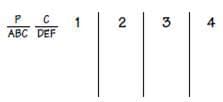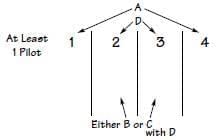Practice Question - 38 (Complex Arrangement) | 100 DILR Questions for CAT Preparation PDF Download
Planes 1, 2, 3, and 4—and no others—are available to fly in an air show.
I. Pilots Anna, Bob, and Cindy are all aboard planes that are flying in the show and they are the only qualified pilots in the show.
II. Copilots Dave, Ed, and Fran are all aboard planes that are flying in the show and they are the only qualified copilots in the show.
III. No plane flies in the show without a qualified pilot aboard.
IV. No one but qualified pilots and qualified copilots flies in the show.
V. Anna will only fly in either plane 1 or plane 4.
VI. Dave will only fly in either plane 2 or plane 3.
1. If Anna flies in plane 4 and Dave flies in plane 2, which one of the following must be true?
A. Cindy flies in either plane 1 or plane 3.
B. If Cindy flies in plane 3, Bob flies in plane 2.
C. Bob and one other person fly in plane l.
D. If Bob is aboard plane 4, Cindy flies in plane 3.
E. If Cindy is in plane 2, Bob flies in plane 3.
2. If Bob and Anna fly on the same plane, which one of the following must be true?
A. Cindy flies with Dave and Ed.
B. Cindy flies with Ed.
C. Dave flies with Cindy.
D. Dave flies with Cindy, Ed, and Fran.
E. Fran flies with Ed.
3. If Cindy and Fran are the only people in one of the planes, which one of the following must be true?
A. Bob flies with Anna.
B. Dave flies with Ed.
C. Dave and Ed fly with Bob.
D. Dave flies with Bob.
E. Ed flies with Anna.
4. If plane 1 is used, its crew could consist of
A. Anna, Bob, Cindy, Fran
B. Anna, Bob, Ed, Fran
C. Bob, Cindy, Ed, Fran
D. Bob, Cindy, Dave, Ed
E. Bob, Dave, Ed, Fran
5. If as many of the pilots and copilots as possible fly in plane 4, that group will consist of
A. exactly two people
B. exactly three people
C. exactly four people
D. exactly five people
E. three pilots and two copilots
 View Answer
View Answer 
The Action: In this grouping game, we're asked to distribute six entities—three pilots and three copilots—among four planes—planes 1, 2, 3, and 4. While the numbering of the planes may suggest sequencing, your overview should have dispelled that misconception right away: There's no mention that these planes are "in a row;" they're not numbered "from left to right;" and none of the rules say anything about people being "in adjacent planes," or anything like that. Our job is simply to distribute the pilots and copilots into the planes.
The main Key Issue, therefore, is a grouping concern:
1) Who’s in what plane? And by extension: Which pilots and copilots can, must, or cannot
fly in the same plane as which other pilots and copilots?
The Initial Setup: Keep this setup simple; four circles or columns, numbered 1 to 4, can represent the planes. Then list the pilots and copilots off to the side:
The Rules:
1) and 2) You most likely already used these rules to get a handle on the entities. However, some test takers overlooked a key element of these rules—that the pilots and copilots “are all aboard planes that are flying in the show.” This means that everyone flies. Selecting who flies isn’t an issue; they’re all up in the air. The only question here is which plane each person is in. As for listing the entities, some find it helpful to use capital letters for the pilots and lowercase letters for the copilots, some don’t. Do what’s easiest for you.
3) Translation: Every plane that’s flying needs one pilot—at least one. This rule says nothing about copilots, nor does it imply that only one pilot may fly in a particular plane. So far, it’s quite possible that exactly one pilot flies a plane without a copilot, just as it’s possible for more than one pilot to fly in one plane.
4) This rule is basically a loophole closer to ensure that no one from the audience or anywhere else rushes out and pilots a plane.
5) Anna will only fly in plane 1 or plane 4. Since everyone is flying in the show, we know that one of these planes must be used. To build this into our master sketch, write “A” with arrows pointing to planes 1 and 4.
6) Dave only flies in plane 2 or plane 3— “D” with arrows to 2 and 3 takes care of this. Key Deductions: Not much in the way of deductions, but there are a few issues that are worth working out before hitting the questions. First, the numbers: No plane flies without a qualified pilot aboard. But we have only three qualified pilots, which means that a maximum of three of the four planes are flying; at least one is going to remain empty and on the ground. Also, since a plane can’t fly without a pilot (Rule 3), we know that one of the pilots must join Dave (a copilot) in either plane 2 or plane 3. It can’t be Anna, since she’s in plane 1 or 4, so Dave must fly with either B or C, in plane 2 or 3.
The Final Visualization: Here’s what we’re armed with to reel in these five questions:
Ans. 1 (B)
Anna is in plane 4 and Dave is in plane 2. Well, we knew we’d have to focus on the Dave situation, and here it is right off the bat. Since Bob or Cindy (or both) needs to accompany Dave, Cindy in 3 forces Bob into 2 with Dave.
(A) No reason why Cindy couldn’t fly in plane 2 with Dave.
(C) No, Bob could fly in plane 2.
(D) No; if Bob flies in plane 4, Cindy would have to fly with Dave in plane 2.
(E) If Cindy flies in plane 2 with Dave, then Bob could fly in any of the planes.
Ans. 2 (C)
Anna can’t fly with Dave (Rules 5 and 6). If Bob joins Anna, he can’t fly with Dave. So Cindy would have to fly with copilot Dave, choice (C). Choices (A), (B), (D), and (E) all could be true, but none of them must be true.
Ans. 3 (D)
Cindy and Fran fly alone, Anna never flies with Dave, so Bob must fly with Dave, choice (D). (A) is dead wrong, and (B), (C), and (E) are merely possible.
Ans. 4 (B)
This is very much like a standard acceptability question. (D) and (E) bite the dust thanks to Rule 6. Dave can’t fly in 1 but must have a pilot with him in plane 2 or 3, so any prospective plane-1 crew that included all three pilots would be impossible. That eliminates Choice (A). (C) leaves only Anna to join Dave which isn’t possible. That leaves us with (B)—Anna, Bob, Ed, and Fran—a perfectly acceptable crew for plane 1, with Cindy and Dave in plane 2 or 3.
Ans. 5 (C)
Dave and one pilot can’t be in 4, but everybody else can be. That's the maximum, four people, choice (C).
|
102 videos|123 docs|121 tests
|
FAQs on Practice Question - 38 (Complex Arrangement) - 100 DILR Questions for CAT Preparation
| 1. What is the format of the CAT exam? |  |
| 2. How can I prepare effectively for the CAT exam? |  |
| 3. What are the eligibility criteria for the CAT exam? |  |
| 4. How is the CAT exam scored? |  |
| 5. What are the common mistakes to avoid while taking the CAT exam? |  |















